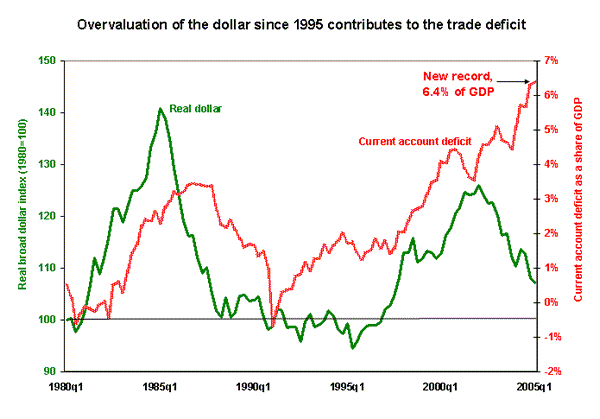See Snapshots Archive.
Snapshot for June 17, 2005.
U.S. current account deficit continues to grow to record high
The Bureau of Economic Analysis (BEA) announced today that the current account (the broadest measure of the U.S. deficit in the trade of goods, services, and payments to the rest of the world) reached an all-time high of $780 billion in the first quarter of 2005, an increase of 15% over the fourth quarter of 2004. The deficit reached 6.4% of gross domestic product (GDP), also a record level. The U.S. dollar has declined 14.9% since the first quarter of 2002 (as shown in the black line of the following graph). The rapid and continuing growth of the current account deficit, despite the sustained decline in the dollar since the first quarter of 2002, is a major sign of weakness in U.S. traded goods industries. Unfortunately, the deficit is still likely to get worse in the near term.
The declining dollar should make U.S. exports more competitive and imports more expensive. Thus growth of exports should accelerate, and the rate of growth of imports should fall. However, because the trade gap is so large, stabilizing or reducing the trade gap will be very difficult. Imports were 47% larger than exports in the first quarter of 2005. Imports increased 10.7% in the first quarter (a decrease from the average quarterly rate of 23% in 2004). However, exports increased only 8.8%. In order to keep the current account gap from growing, exports would have had to increase 78% faster than they actually did. In other words, exports would have had to increase by 15.6% last quarter just to keep up with the 10.7% growth of imports. Future exports will have to grow much more rapidly to shrink the current account as a share of GDP. In order to stabilize or reduce the current account gap, the dollar will have to fall substantially more than it has since early 2002.

As a nation, we are living beyond our means. A trade deficit must be financed by net borrowing from the rest of the world. The United States was effectively spending about 6.4% more than it was producing in the first quarter of 2005 (slightly more than $2 billion every day), but it cannot continue to borrow at such high levels forever. Worse yet, the trade deficit is growing each year as a share of GDP. The decline in the value of the dollar since February 2002-primarily the 26% decline against the Euro (which has weakened recently)-has failed to stem the increase in the current account deficit, which has increased by 1.6 percentage points as a share of real GDP since the first quarter of 2003.
If the dollar were being supported by demand from investors who find the U.S. market attractive, then steady growth in capital inflows from private investors to finance rising deficits would likely occur. However, private inflows have been insufficient to finance the U.S. current account deficit for the last three years. Instead, foreign governments have served as lenders of last resort, purchasing substantial volumes of U.S. government assets. The BEA reported today that these purchases equaled an annual rate of about $100 billion in the first quarter of 2005.
A bloc of Asian governments made purchases equal to 132% of all net government purchases of U.S. assets in the first quarter of 2005. Thus, these governments were willing to offset net official sales of U.S. assets by governments in the rest of the world. The unwillingness of other foreign governments to continue holding large stocks of U.S. government assets highlights the determination of Asian governments to serve as lenders of last resort in financial markets. These governments-especially China, Japan and Korea-are willing to absorb the risks of financial losses from an ultimate decline in the dollar in order to make their exports more competitive against U.S. products. If these governments had not been intervening in foreign exchange markets, then the dollar would have fallen much more than it has since 2002. In fact, most of the dollar’s decline occurred in 2002-03-in the past year the real value of the dollar has only fallen 0.5%. The dollar would have declined much more rapidly, especially against Asian currencies, if there had been no foreign government intervention in currency markets. If the dollar did decline fully, the prospects for stabilizing or shrinking the U.S. current account deficit would be greatly improved.
Today’s Snapshot was written by EPI economist Robert E. Scott with research assistance from David Ratner.